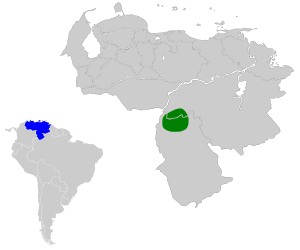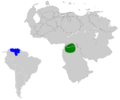White-faced whitestart facts for kids
Quick facts for kids White-faced whitestart |
|
|---|---|
| Conservation status | |
| Scientific classification | |
| Genus: |
Myioborus
|
| Species: |
albifacies
|
 |
|
The white-faced whitestart (Myioborus albifacies), also called the white-faced redstart, is a small, colorful bird that belongs to the Parulidae family. This family includes many types of warblers. This special bird lives only in a specific part of the world, making it endemic to that area. It can be found in the humid, high-up forests of the tepuis in southwestern Venezuela. Because it lives in such isolated places, not much is known about this bird.
Contents
What is a White-faced Whitestart?
The white-faced whitestart is a small songbird. It gets its name from the white feathers on its face. These birds are known for their bright colors, which often include shades of yellow, orange, and black, along with the distinctive white markings. They are active birds that often move quickly through the trees.
Appearance of the White-faced Whitestart
This bird is about 13 to 13.5 centimeters (around 5 inches) long. It has a mostly dark body, often with a grayish or blackish back. The most striking feature is its face, which has a clear white patch, especially around its eyes and forehead. This white patch stands out against its darker head feathers. Its belly and chest are usually a bright yellow or orange, which makes it easy to spot against the green forest. Its tail often has white outer feathers, which it might flash when it flies or moves.
Where Do They Live?
The white-faced whitestart lives in a very unique place: the tepuis of southwestern Venezuela. Tepuis are like giant, flat-topped mountains with very steep sides. They are often called "table mountains." These isolated mountains have their own special ecosystems, meaning the plants and animals living there are often found nowhere else on Earth. The white-faced whitestart prefers the humid, or very moist, highland forests on these tepuis. It lives at high elevations, usually between 1,000 and 2,000 meters (about 3,300 to 6,600 feet) above sea level.
Tepui Habitats
The forests on the tepuis are often misty and wet, with lots of mosses, ferns, and unique plants. This environment provides the perfect home for the white-faced whitestart. They spend most of their time in the middle and upper parts of the trees, searching for food. The isolation of the tepuis means these birds have been able to evolve without much disturbance from humans, but it also means their habitat is very specific and limited.
What Do White-faced Whitestarts Eat?
Like most warblers, the white-faced whitestart mainly eats insects. They are very active foragers, meaning they are always on the move looking for food. They often fly out from a branch to catch insects in mid-air, a behavior called "flycatching." They also pick insects off leaves and branches. Their diet helps control insect populations in their forest homes.
Foraging Behavior
These birds are known for their energetic movements. They often fan their tails and flick their wings as they move through the branches. This behavior might help to startle insects, making them easier to catch. They are usually seen alone or in pairs, but sometimes they might join mixed-species flocks, which are groups of different bird species foraging together.
Reproduction and Life Cycle
Not much is specifically known about the reproduction of the white-faced whitestart due to its isolated habitat. However, like other birds in the Parulidae family, they likely build cup-shaped nests, often hidden in dense vegetation or on the ground. The female typically lays a few eggs, and both parents might help with raising the young. Baby birds, called chicks, hatch from the eggs and are cared for by their parents until they are old enough to fly and find food on their own.
Conservation Status
The white-faced whitestart is listed as "Least Concern" by the International Union for Conservation of Nature (IUCN). This means that, for now, its population is considered stable and not at high risk of extinction. However, because it lives in such a specific and isolated area, any changes to its tepui habitat could affect it. Protecting the unique forests of the tepuis is important for the future of this beautiful bird.
Images for kids
See also
 In Spanish: Candelita cariblanca para niños
In Spanish: Candelita cariblanca para niños



